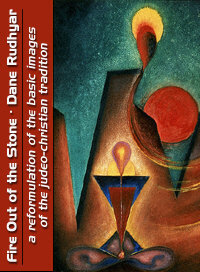 |
| Home | Bio | Art | Music | Literature | Civilization & Culture | Philosophy of Wholeness | Theosophy & Spirituality | Astrology |

FIRE OUT OF THE STONE A Reformulation of the Basic Images of the Judeo-Christian Tradition by Dane Rudhyar, 1962 1. Not to Repeat, But to Renew 2. The Essence and the Substance • Page 1 • Page 2 • Page 3 3. To Become "More-Than-Man" 4. The Fatherhood of God 5. At the Center is Soul 6. Creation and Evolution 7. Crisis and Sin 8. The Coming-Together of God and Man 9. Christ-Love: The Covenant with Individual 10. The Life of Mediation and its Paradox
: : :
This title was first published by Sevire, 1963. Cover for the online edition copyright © 2008 by Michael R. Meyer. : : : : : :
"Thy God is a cosumming fire." Duet. 4:25 "He shall baptize you with the Holy Spirit and with fire." Matthew 3:11 "I am come to send fire on the earth." Luke 12:49
: : :
|

2. THE ESSENCE AND THE SUBSTANCE - page 2"For the letter killeth, but the spirit quickeneth".
II Corinthians 3 : 6 "For the letter killeth, but the spirit quickeneth". John 4:24 When Christianity began to be interpreted as a new Mystery-religion, especially through the apostolic zeal of Paul, it was indeed easy to incorporate into the new Mystery this doctrine of an Atonement planned by God as a means to neutralize and "redeem" the Fall of Man in the Original Sin. It was easy because the old Mysteries had for centuries included "sacred feasts" at which the initiates celebrated, by a ritual meal (a communion), their mystic participation in the springtide of the resurrected life of the earth. It is the picture of such a sacred passover meal which we see emerging from John's narrative. But it seemed necessary to Paul, and to at least some of the Apostles, that an even more poignantly dramatic element be incorporated into such a Mystery-ritual, that is, the emotional element of salvation, felt as an intensely personal experience of freedom from the "body of corruption" — of freedom through death, a death mysteriously transformed into a supernatural kind of immortality. Thus the Crucifixion - the divine Sacrifice — became the central event in the ritual of the Christ-life. It became the divine Act, par excellence. The "love of God" was seen operating primarily in and through that Act. God's love consisted in this: that He offered His one and only Son to save man from the Original Sin. Death became the demonstration of this love, rather than life; the negation of a negation (the obliteration of sin) took the place of a creative affirmation in the mind and soul of the typical Christian. The Mystery-religions of the East-Mediterranean world were fundamentally religions of life. Death was merely a crisis directed toward more life. The seed died in the soil during germination, not to "save" the elements of that soil from an original sin, but in order that, by integrating the chemicals of the earth into a new plant from which would come many more seeds, life might be produced "more abundantly". Germination is a necessary event in the life of the seed, but it is not the central fact; the central fact is that, in the seed, the potency of immortal life and cyclic rebirth is focused. The old Mystery-religions glorified this central fact, and sought to make every participant feel and experience its reality at the psychic-spiritual human level. They used the biological fact as a symbol; but more, they used the representation of it as a "magical" means to induce the participant in the Mystery to identify himself with the creative process of life at any level; indeed, to be Life in a focused, individualized and creative expression. In the Christian Mystery-religion there is also an identification with Christ, the crucified and resurrected divine Being. But what is different is the psychological motive for the identification. Paul's passionate aspiration is to be free from sin, to be crucified ("for he that is dead is freed from sin") so that having died in the likeness of Jesus' death he "shall be also in the likeness of his resurrection" (Romans 6:5). His yearning for redemption and salvation derives from a vivid and unrelenting sense of guilt perhaps caused or heightened by the memory of his earlier years during which he persecuted Christ's followers. Such an attitude, intensely personal and poignant, was unknown to men of the Greek and Egyptian civilizations; but it won to Christianity the fervent and passionate allegiance of the men of the disintegrating Hellenic Society. Christianity spread as the religion of "the Fall and Redemption of man", with Christ as the unique and mysterious means to the Redemption; and this "Image of Christ" has dominated European Christianity and its worldwide expansion. Yet such an "Image" could not be drawn directly from Jesus' words, at least as we have them! It constitutes an interpretation of the events of his life. More precisely, it was the result of the impact of this life upon some of his followers. It depicts the way these followers made the events of Christ's life answer their personal problems and, by extension, the problems of men of their time and of their type. If one attempts to separate this interpretation by Jesus' early Jewish followers from the Christianity which, from medieval Rome, dominated the whole of Europe, what remains is (1) the ethical and spiritual teachings of Jesus; then (2) the great drama of the life of Jesus as the incarnate Christ. This drama retains its character and meaning as a symbolic ritual of divine manifestation and work; but it loses the tragic and somber emotional atmosphere which thoroughly pervaded medieval Christianity and is still evident in most traditional Churches today. Freed from this psychological gloom, this life-negation and this yearning for vicarious salvation, the life of Christ Jesus appears as the substance of a new Mystery-religion. What makes this Mystery-religion new and distinct from the old Hellenic Mysteries is the great revelation which Jesus brought to humanity - the revelation of a love which is God's very essence, a love which can conquer the world because it is universal and "celestial", because it is a transfigured expression of life. Jesus' God is a God who is love, as the God of the pre-Christian Mysteries was a God who was life. The ancient Image of the universal Waters of Life flowing from the celestial sun became transfigured into the radiant Image of the divine love of God pouring itself upon all men, giving to all the power of the Holy Spirit. It poured out into the world from the Father-Creator, and through the Son, Christ. By means of such a transfiguration Jesus transformed the very substance of the Mystery-religions. He gave to the Mystery-religions a new quality, a new purpose, a new realization of the meaning of immortality. He gave them a new morality, a new spiritual tone. And this tone made history. He who can change the basic Image which the men of a civilization make of God and of life always makes history. But the change Jesus made was fundamental. It raised the consciousness, or perhaps even more the feeling nature of humanity, from one level to another. This "raising of level" was obviously more a potentiality than an actuality, for the Western world witnessed relatively few instances of its tangible results during the last nineteen centuries. Yet it can truly be said to have marked the spiritual beginning - the "seed"-beginning — of a new era. The spirit of this era had already been manifest to a considerable degree in the reform of Buddhism which took place in Northern India about a century before Jesus' time (Mahayana Buddhism). But Jesus not only spoke and taught the Mystery, he performed it. He acted out Christ. He was Christ acting, God-in-act. Through this Mystery-performance, which was his life he released into humanity a divine power, the Christ-impulse. And this Christ-impulse definitely ushered in a new era of human evolution. It set in motion a new rhythm of spirit. It made divine love human and established this love as a foundation in the earth, as the source of a new human cycle, as a "living Breath" that will not fade away for many thousands of years. This "living Breath", this Christ-impulse, is as real, as vital today as it ever was since the Baptism and the Transfiguration; and the words of Christ Jesus still are channels through which radiate the love of God - "seed ideas" potent with the birthing of many a future civilization. These two factors are essential Christianity. All else is interpretation and formulation. All else constitutes particular historical answers to the historical needs of particular societies. To say this does not make these historical answers less valid or less real; but it shows that they belong to a different level of truth and reality. Each new cycle of civilization demands a new interpretation and formulation. Each particular phase of these cycles is bound to emphasize certain characteristic aspects of the basic interpretation. All are necessary which prove historically significant and morally or spiritually transforming for the society which calls for them. But they are "historical" values, not "essential" values. And the doctrines of the Atonement and of the Redemption of Sin are not essential Christian values. They are interpretations, even though they were no doubt necessary and inevitable in Paul's time as vehicles for the establishment of Christianity, as "carrier-waves" for the great theme of divine love.  Home | About | Calendar | Ephemeris Charts | Art Gallery | Library | Resources Shop | Rudhyar Archival Project | Help Web design and all data, text and graphics appearing on this site are protected by US and International Copyright and are not to be reproduced, distributed, circulated, offered for sale, or given away, in any form, by any means, electronic or conventional. See Notices for full copyright statement and conditions of use. Web design copyright © 2000-2004 by Michael R. Meyer. All Rights Reserved. |